HTTP Header Oversize (HHO)
An HTTP request header contains vital information for intermediate systems and web servers. This includes cache-related header fields or meta data on client supported media types, languages and encodings. The HTTP standard does not define any size limit for HTTP request headers. As a consequence, intermediate systems, web servers, and web frameworks define limits by their own. Most web servers and proxies such as Apache HTTPD provide a request header size limit of around 8,192 bytes to mitigate, e.g., Request Header Buffer Overflow or ReDoS attacks. However, there are also intermediate systems that specify limits larger than 8,192 bytes. For instance, the Amazon Cloudfront CDN allows up to 20,480 bytes. This semantic gap in terms of request header size limits can be exploited to conduct a cache poisoning attack which can lead to a denial of service.
HHO CPDoS attacks work in scenarios where a web application uses a cache that accepts a larger header size limit than the origin server. To attack such a web application, a malicious client sends a HTTP GET request including a header larger than the size supported by the origin server but smaller than the size supported by the cache. To do so, an attacker has two options. First, she crafts a request header with many malicious headers as shown in the following Ruby code snippet. The other option is to include one single header with an oversized key or value.
require 'net/http'
uri = URI("https://example.org/index.html")
req = Net::HTTP::Get.new(uri)
num = 200
i = 0
until i > num do
req["X-Oversized-Header-#{i}"] = "Big-Value-0000000000000000000000000000000000"
i +=1;
end
res = Net::HTTP.start(uri.hostname, uri.port, :use_ssl => uri.scheme == 'https') {|http|
http.request(req)
}
The figure below shows an HHO CPDoS attack flow in which a malicious client sends a request created by the above code snippet. The cache forwards this request including all headers to the endpoint since the header size remains below the size limit of 20,480 bytes. The web server, however, blocks this request and returns an error page, as the request header exceeds its header size limit. This error page with status code 400 Bad Request is now stored by the cache. All subsequent requests targeting the denialed resource are now provided with an error page instead of the genuine content.

The video demonstrates the HHO CPDoS attack with an example web application hosted on Cloudfront. In the attack, embedded web resources are selectively replaced by error pages rendering first some parts of the web page and finally the entire page unavailable.
HTTP Meta Character (HMC)
The HTTP Meta Character (HMC) CPDoS attack works similar to the HHO CPDoS attack. Instead of sending an oversized header, this attack tries to bypass a cache with a request header containing a harmful meta character. Meta characters can be, e.g., control characters such as line break/carriage return (\n), line feed (\r) or bell (\a).
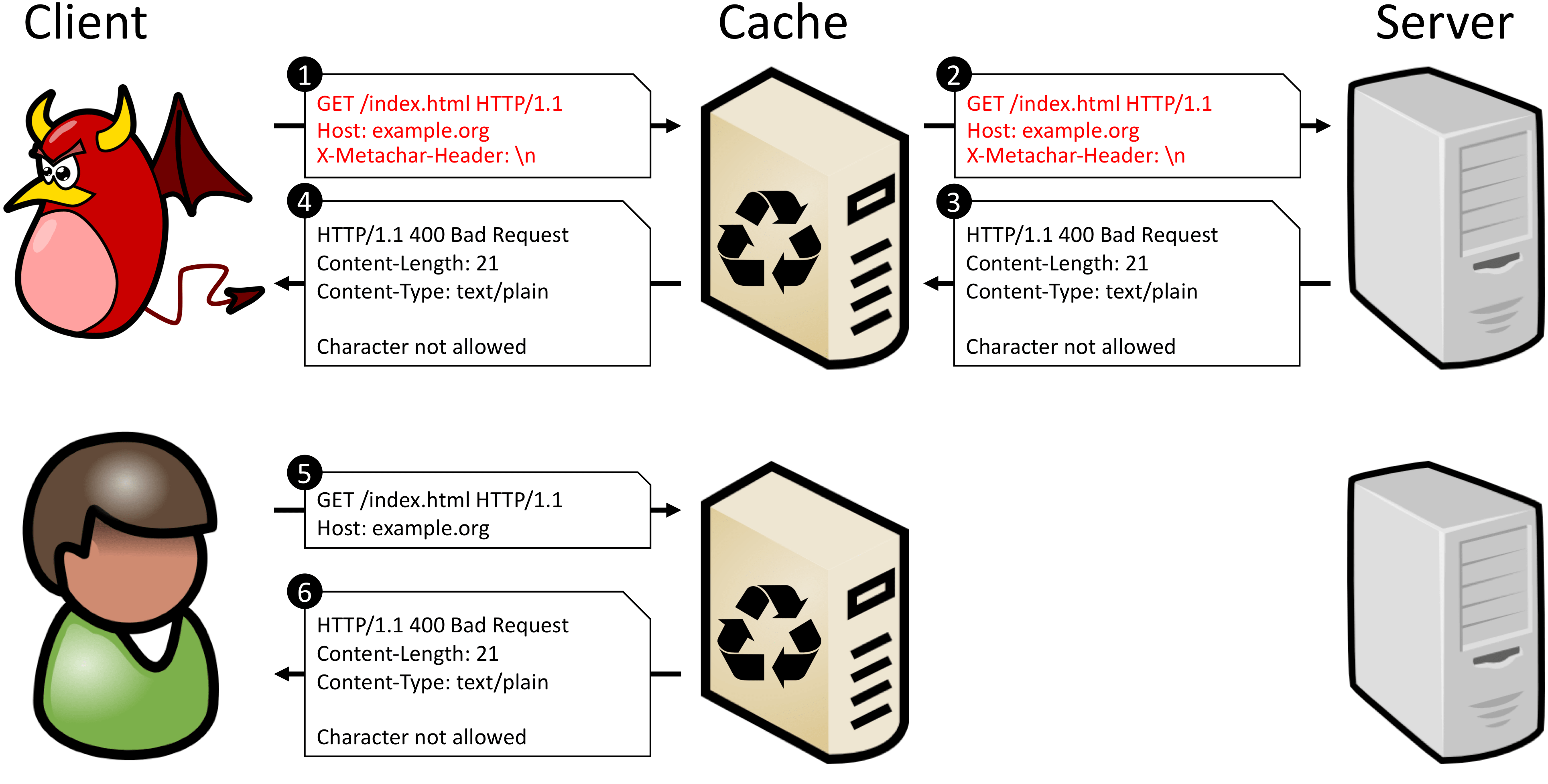
An unaware cache forwards such a request to the origin server without blocking the message or sanitizing the meta characters. The origin server, however, may classify such a request as malicious as it contains harmful meta characters. As a consequence, the origin server returns an error message which is stored and reused by the cache.
HTTP Method Override Attack (HMO)
The HTTP standard provides several HTTP methods for web servers and clients for performing transactions on the web. GET, POST, DELETE and PUT are arguably the most used HTTP methods in web applications and REST-based web services. Many intermediate systems such as proxies, load balancers, caches, and firewalls, however, do only support GET and POST. This means that HTTP requests with DELETE and PUT are simply blocked. To circumvent this restriction many REST-based APIs or web frameworks such as the Play Framework 1, provide headers such as X-HTTP-Method-Override, X-HTTP-Method or X-Method-Override for tunnel blocked HTTP methods. Once the request reaches the server, the header instructs the web application to override the HTTP method in the request line with the one in the corresponding header value.
POST /items/1 HTTP/1.1
Host: example.org
X-HTTP-Method-Override: DELETE
HTTP/1.1 200 OK
Content-Type: text/plain
Content-Length: 62
Resource has been successfully removed with the DELETE method.
The code snippet shows a request that can bypass a security policy that prohibits DELETE requests by using the X-HTTP-Method-Override header. On the server-side this POST request will be interpreted as a DELETE request.
These method overriding headers are very useful in scenarios when intermediate systems block distinct HTTP methods. However, if a web application supports such a header and also uses a web caching system like a reverse proxy cache or CDN for optimizing performance, a malicious client can exploit this constellation to conduct a CPDoS attack. The figure below illustrates the principle flow of an HTTP Method Override Attack (HMO) CPDoS attack using the X-HTTP-Method-Override header.
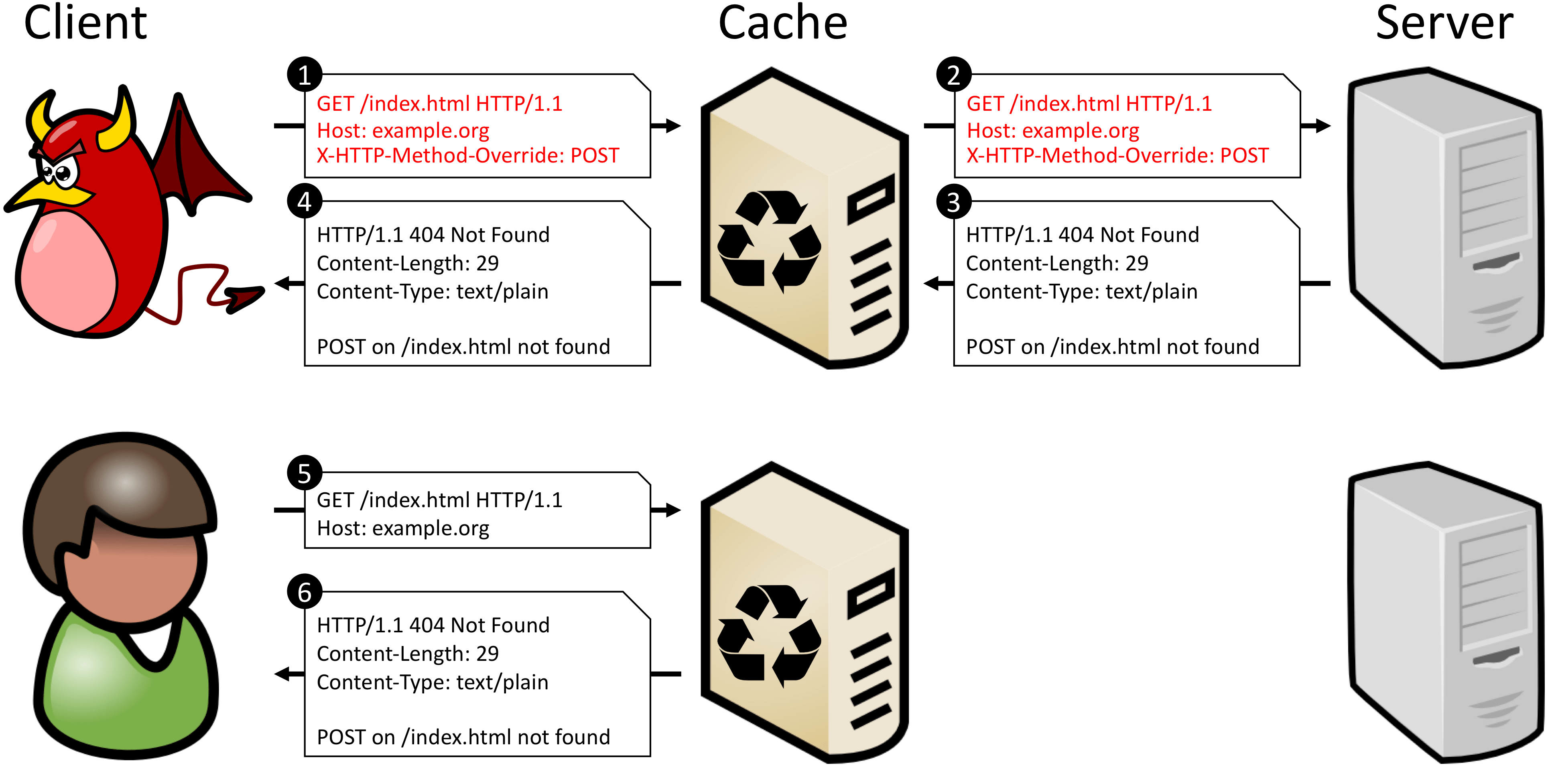
Here, the attacker sends a
GET request with an X-HTTP-Method-Override header containing POST. A vulnerable cache interprets this request as a benign GET request targeting the resource https://example.org/index.html. The web application, however, will interpret this request as a POST request, since the X-HTTP-Method-Override header instructs the server to replace the HTTP method in the request line. Accordingly, the web application returns a response based on POST. Let’s assume that the target web application doesn’t implement any business logic for POST on /index.html. In such cases, web frameworks like the Play Framework 1 return an error message with the status code 404 Not Found. The cache assumes that the returned response with the error code is the result of the GET request targeting https://example.org/index.html. Since the status code 404 Not Found is allowed to be cached according to the HTTP Caching RFC 7231, caches store and reuse this error response for recurring requests. Each benign client making a subsequent GET request to https://example.org/index.html will receive a stored error message with status code 404 Not Found instead of the genuine web application’s start page.The video below demonstrates an HMO attack on a web application. Here, the attacker uses the Postman tool to block the start page from being accessed.
Impact
The map below shows the impact of CPDoS attacks on CDNs. Once the error page is injected, the CDN distributes it to many other edge cache server locations around the world. The map illustrates how far the error page is distributed to several edge locations within the CDN. The  icons show the affected locations displaying the error page. Fortunately, not all edge servers are infected by this attack which is shown by the
icons show the affected locations displaying the error page. Fortunately, not all edge servers are infected by this attack which is shown by the  icons. This icon denotes the locations where clients receive the genuine page. The
icons. This icon denotes the locations where clients receive the genuine page. The  icon shows the location of the origin server and the
icon shows the location of the origin server and the  icon displays the attacker’s locations.
icon displays the attacker’s locations.
The first figure shows the affected regions in Europe and some parts of Asia when sending a CPDoS attack from Frankfurt, Germany to a victim origin server in Cologne, Germany. The second one illustrates the poisoned regions in the USA when executing a CPDoS attack from Northern Virginia, USA to the same victim origin server in Cologne, Germany.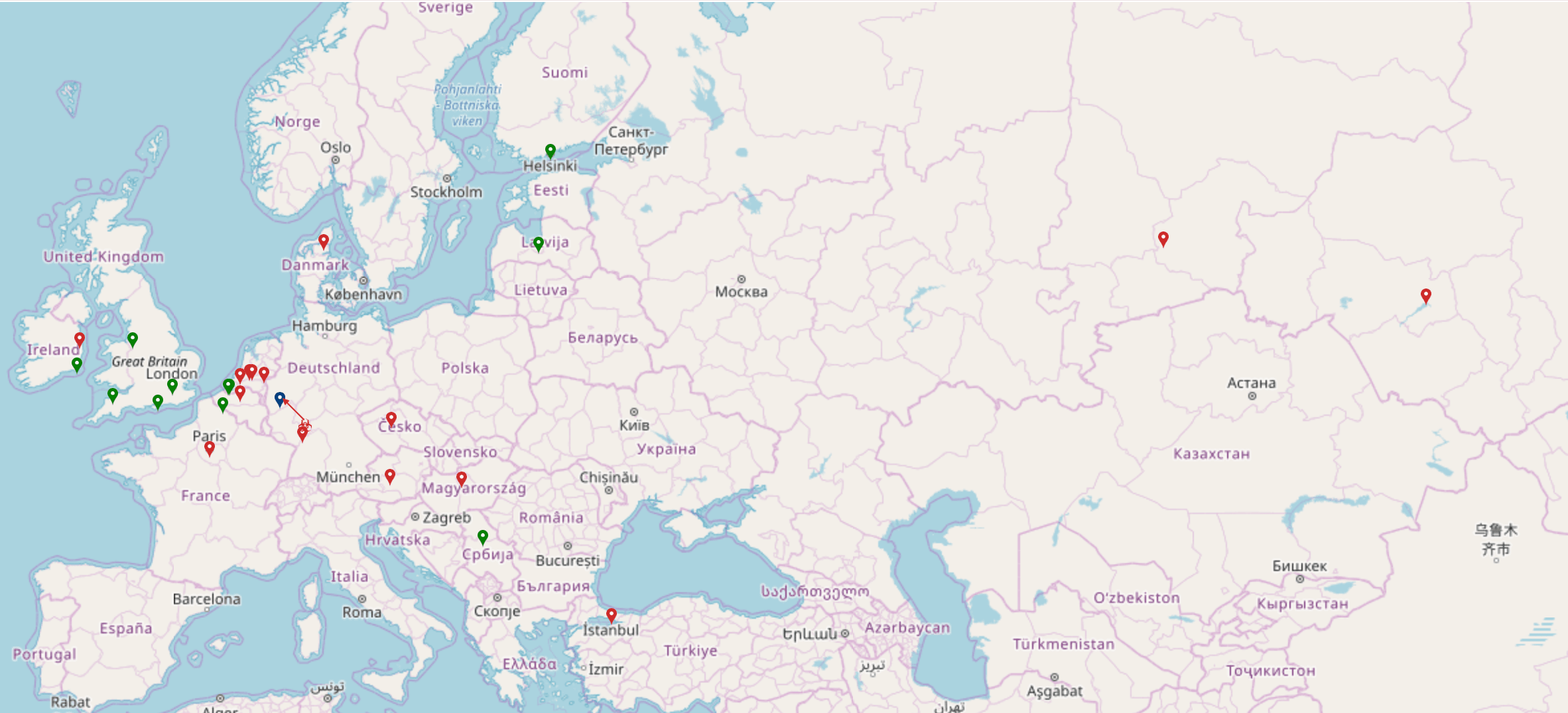
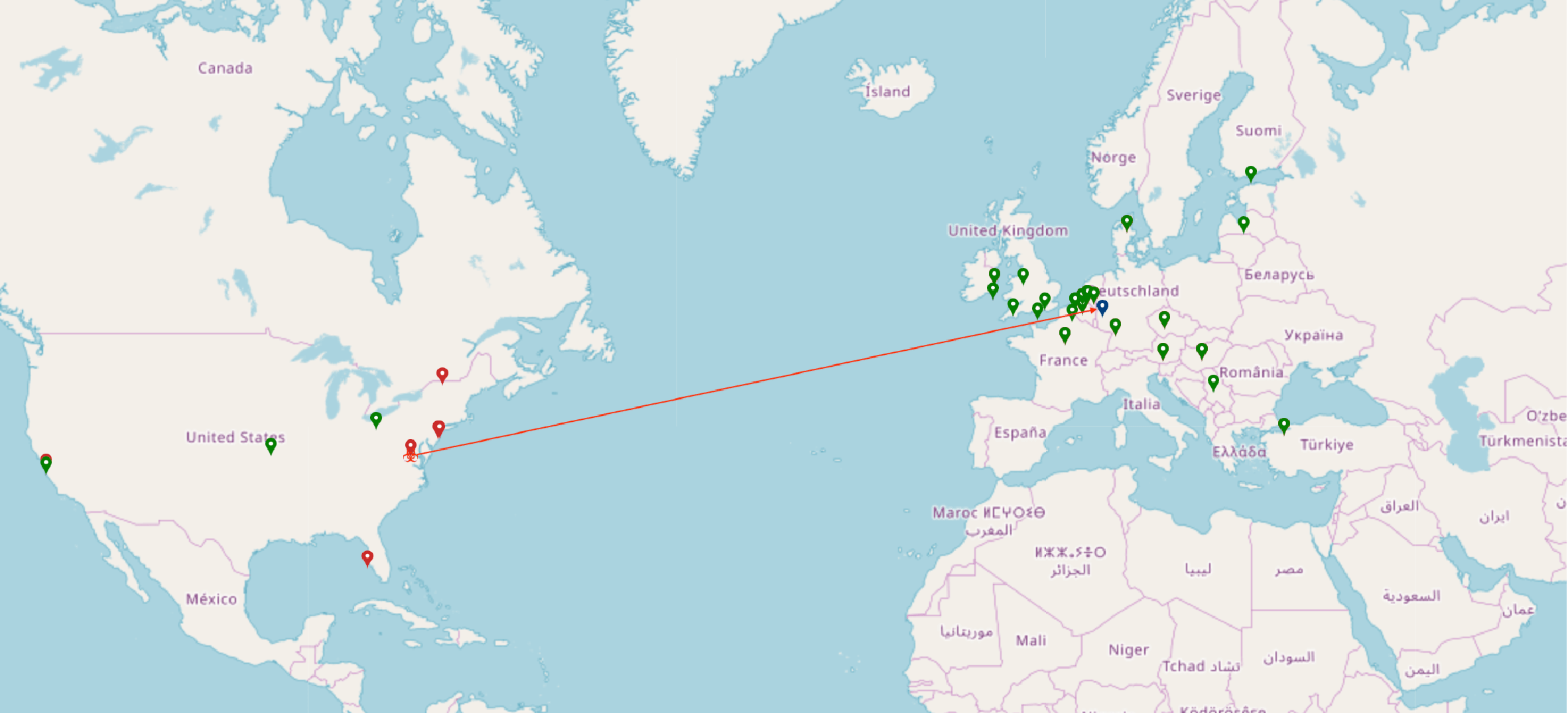
This analysis has been conducted with TurboBytes Pulse and the speed testing tool of KeyCDN. Both services provide a testing environment covering a lot of test agents scattered around the world.
CPDoS vulnerability overview
This overview summarizes what pair of web caching system and HTTP implementation is vulnerable to what CPDoS attack. More details are described in the paper which can be downloaded below.
HTTP ImplementationCache | Apache HTTPD | Apache TS | Nginx | Squid | Varnish | Akamai | Azure | CDN77 | CDNSun | Cloudflare | CloudFront | Fastly | G-Core Labs | KeyCDN | StackPath |
|---|
Apache HTTPD + (ModSecurity) | ○ | ○ | ○ | ○ | ○ | ○ | ○ | ○ | ○ | ○ | HHO, HMC | ○ | ○ | ○ | ○ |
Apache TS | ○ | ○ | ○ | ○ | ○ | ○ | ○ | ○ | ○ | ○ | ○ | ○ | ○ | ○ | ○ |
Nginx + (ModSecurity) | ○ | ○ | ○ | ○ | ○ | ○ | ○ | ○ | ○ | ○ | HHO | ○ | ○ | ○ | ○ |
IIS | ○ | ○ | ○ | ○ | (HHO) | (HHO) | ○ | (HHO) | ○ | (HHO) | HHO, HMC | (HHO) | ○ | ○ | ○ |
Tomcat | ○ | ○ | ○ | ○ | ○ | ○ | ○ | ○ | ○ | ○ | HHO | ○ | ○ | ○ | ○ |
Squid | ○ | ○ | ○ | ○ | ○ | ○ | ○ | ○ | ○ | ○ | ○ | ○ | ○ | ○ | ○ |
Varnish | ○ | ○ | ○ | ○ | ○ | ○ | ○ | ○ | ○ | ○ | HHO, HMC | ○ | ○ | ○ | ○ |
Amazon S3 | ○ | ○ | ○ | ○ | ○ | ○ | ○ | ○ | ○ | ○ | HHO | ○ | ○ | ○ | ○ |
Google Cloud Storage | ○ | ○ | ○ | ○ | ○ | ○ | ○ | ○ | ○ | ○ | ○ | ○ | ○ | ○ | ○ |
Github Pages | ○ | ○ | ○ | ○ | ○ | ○ | ○ | ○ | ○ | ○ | HHO, HMC | ○ | ○ | ○ | ○ |
Gitlab Pages | ○ | ○ | ○ | ○ | ○ | ○ | ○ | ○ | ○ | ○ | HMC | ○ | ○ | ○ | ○ |
Heroku | ○ | ○ | ○ | ○ | ○ | ○ | ○ | ○ | ○ | ○ | HHO | ○ | ○ | ○ | ○ |
ASP.NET | ○ | ○ | ○ | ○ | (HHO) | (HHO) | ○ | (HHO) | ○ | (HHO) | (HHO), (HMC) | (HHO) | ○ | ○ | ○ |
BeeGo | ○ | ○ | ○ | ○ | ○ | ○ | ○ | ○ | ○ | ○ | HMC | ○ | ○ | ○ | ○ |
Django | ○ | ○ | ○ | ○ | ○ | ○ | ○ | ○ | ○ | ○ | (HHO), (HMC) | ○ | ○ | ○ | ○ |
Express.js | ○ | ○ | ○ | ○ | ○ | ○ | ○ | ○ | ○ | ○ | HMC | ○ | ○ | ○ | ○ |
Flask | ○ | ○ | ○ | ○ | ○ | (HMO) | ○ | ○ | ○ | ○ | HMO, (HHO), (HMC) | ○ | ○ | ○ | ○ |
Gin | ○ | ○ | ○ | ○ | ○ | ○ | ○ | ○ | ○ | ○ | HMC | ○ | ○ | ○ | ○ |
Laravel | ○ | ○ | ○ | ○ | ○ | ○ | ○ | ○ | ○ | ○ | (HHO), (HMC) | ○ | ○ | ○ | ○ |
Meteor.js | ○ | ○ | ○ | ○ | ○ | ○ | ○ | ○ | ○ | ○ | HMC | ○ | ○ | ○ | ○ |
Play 1 | ○ | ○ | ○ | ○ | HMO | HMO | ○ | HMO | ○ | HMO | HHO, HMO | HMO | ○ | ○ | ○ |
Play 2 | ○ | ○ | ○ | ○ | ○ | ○ | ○ | ○ | ○ | ○ | HHO, HMC | ○ | ○ | ○ | ○ |
Rails | ○ | ○ | ○ | ○ | ○ | ○ | ○ | ○ | ○ | ○ | (HHO), (HMC) | ○ | ○ | ○ | ○ |
Spring Boot | ○ | ○ | ○ | ○ | ○ | ○ | ○ | ○ | ○ | ○ | HHO | ○ | ○ | ○ | ○ |
Symfony | ○ | ○ | ○ | ○ | ○ | ○ | ○ | ○ | ○ | ○ | (HHO), (HMC) | ○ | ○ | ○ | ○ |
Mitigations
One of the main reasons for HHO and HMC CPDoS attacks lies in the fact that a vulnerable cache illicitly stores responses containing error codes such as 400 Bad Request by default. This is not allowed according to the HTTP standard. The web caching standard only allows to cache the error codes 404 Not Found, 405 Method Not Allowed, 410 Gone and 501 Not Implemented. Hence, caching error pages according to the policies of the HTTP standard is the first step to avoid CPDoS attacks.
Content providers must also use the appropriate status code for the corresponding error case. For instance, 400 Bad Request which is used by many HTTP implementations for declaring an oversized header is not the suitable status code. IIS even uses 404 Not Found when a specific header is exceeded. The right error code for an oversized request header is 431 Request Header Fields Too Large. According to our analysis, this error message is not cached by any web caching systems.
Another effective countermeasure against HHO and HMC CPDoS attacks is to exclude error pages from caching. One approach is to add the header Cache-Control: no-store to each error page. The other option is to disable error page caching in the cache configuration. CDNs like CloudFront or Akamai provide configuration settings to do so.
A Web Application Firewalls (WAF) can also be deployed to mitigate CPDoS attacks. However, WAFs must be placed in front of the cache in order to block malicious content before they reach the origin server. WAFs that are placed in front of the origin server can be exploited to provoke error pages that get cached either.
For more details on possible mitigations and countermeasures, please read our paper.
Paper
For more details on CPDoS attacks, you are welcome to read our research paper. A preprint can be downloaded below.
Hoai Viet Nguyen, Luigi Lo Iacono, and Hannes Federrath
Your Cache Has Fallen: Cache-Poisoned Denial-of-Service Attack
26th ACM Conference on Computer and Communications Security (CCS) 2019
Talks
On November 14th, 2019, we will give a talk on CPDoS attacks at the
CCS 2019. For more information, please take a look at the CCS’ agenda: https://sigsac.org/ccs/CCS2019/…
HHO, HMC and HMO are not the only CPDoS variations. In March 2019, Nathan Davison has detected a CPDoS variation which use CORS headers.
Moreover, James Kettle has published a blog article discussing other variations of CPDoS attacks on real world websites. James is Head of Research at PortSwigger Web Security. He wrote many blog articles on practical web cache poisoning vulnerabilities as well as a new variation of HTTP Request Smuggling denoted as HTTP Desync Attacks.
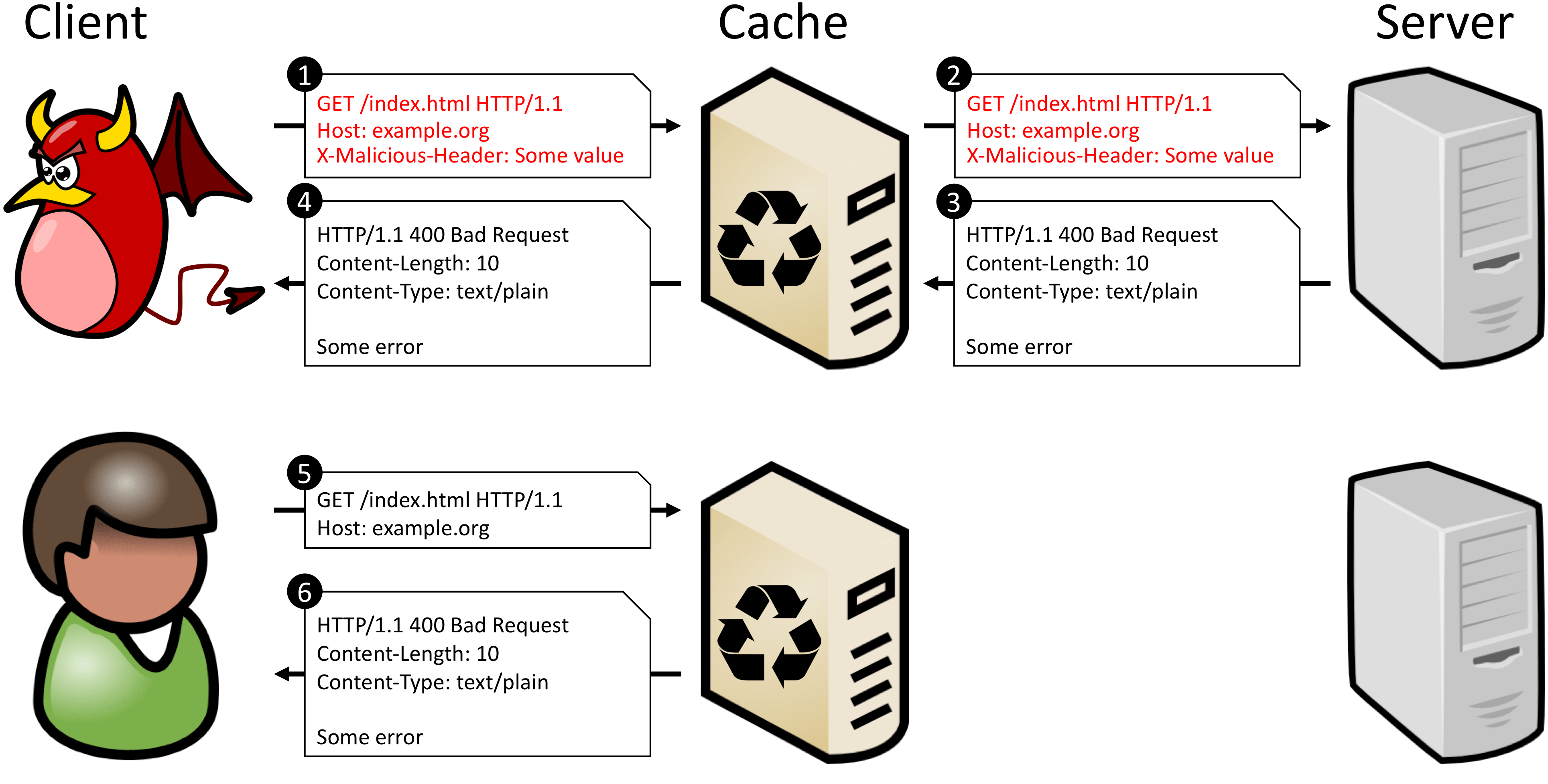



 icons show the affected locations displaying the error page. Fortunately, not all edge servers are infected by this attack which is shown by the
icons show the affected locations displaying the error page. Fortunately, not all edge servers are infected by this attack which is shown by the  icons. This icon denotes the locations where clients receive the genuine page. The
icons. This icon denotes the locations where clients receive the genuine page. The  icon shows the location of the origin server and the
icon shows the location of the origin server and the  icon displays the attacker’s locations.
icon displays the attacker’s locations.
